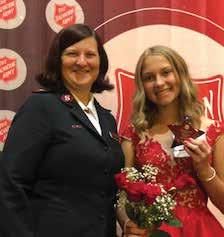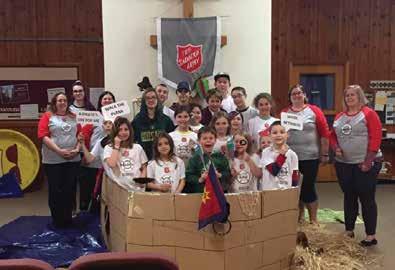
17 minute read
Helping Children Learn from Their Mistakes
HELPING CHILDREN
learn from their mistakes
HELPING CHILDREN

learn from their mistakes
By LEN LANTZ, MD
HAS YOUR CHILD EVER BROKEN A BIG RULE?
There are some situations that no parent wants to deal with. It can be very embarrassing for you and your child when they are in trouble. I consider breaking a big rule to mean that your child: • Shoplifted/stole • Started a physical fight that didn’t involve protecting themselves or someone else • Did drugs or sold drugs • Got suspended from school • Bullied someone relentlessly • Attacked you or a member of your family or engaged in very serious physical threats • Missed curfew or ran away for days or weeks • Skipped school routinely • Engaged in high-risk behavior When you learned about their behavior, what started running through your mind? Like many parents, you might have thought: • “Is this how I raised them?” • “Is this what our family stands for?” • “Do they believe this is right?” • “Is this what their music, video games and friends are teaching them? In your heart, you hope that the answer to every one of the above questions is no. If the answer to any of the above questions is yes or if you don’t know all the answers, then you might have a lot of work to do in finding answers and hopefully stopping repeated rule-breaking behavior.
AN EPISODE DOES NOT EQUAL A PATTERN
I think it’s reasonable to point out that if your child breaks a big rule, it does not necessarily mean that they are doomed to repeat the same mistake. Most parents understand this by instinct. There are many ways to handle a child’s first-time big rule violation. It can be hard to know how to handle it because it is outside your previous parenting experience. Some parents lead with the mother-of-all groundings, which backfires as often as it is effective. Other parents go the route of humiliating their kids.
One of the worst strategies used by parents is shaming and ridiculing their children, often by reciting rules, which is the equivalent of saying, “You’re stupid.”
One of the most effective parenting strategies to use when dealing with your child’s big first-time offense is to get more information. Listen to every one of the excuses they have to offer. I’m not kidding. Ask questions designed to get more specific details without shaming or blaming. Expect some lies at the start, so take written notes and let them know that you are willing to contact every person who knows about the situation to confirm their version of events. Learn as much as you can about their experience, because for a substantial number of kids, getting caught is the greatest punishment. What did they go through, especially when they were caught? What was it like for them?
continued from page 7
Ask them if there is anything else they want you to know. Are there any more details they want to share? In everything they say, make sure to listen for the apology. “I’m sorry” actually counts as an apology in Kid World. Read back to them what happened and what their experience was. Ask them if there are any details that they want to change or that they think they didn’t get quite right. When they are completely done and have let it all out, tell them, “I hear you.”
Then, ask them if they are ready to hear about what you experienced regarding their big mistake. If they say yes, then start immediately. If they say no, then let them know you will share your experience with them tomorrow. Share with your child: “When I heard about (or experienced) your mistake…
My biggest fear was _________.
My most powerful emotion was _________.
My strongest thought was _________.
My initial reaction was to _________ (big consequence), but I don’t believe I should base my decisions only on my initial reaction.
That was a big mistake. I believe in you and that you can learn from this mistake.
We’ll talk about your consequence tomorrow (or let’s talk about your consequence now).”
HOW DO OUR CHILDREN LEARN OUR VALUES?
We teach our values to our children in several ways. The things I’ve listed below, individually or in combination, are some of the most common ways kids see what we believe in. Our children are watching and studying us as often as we are them. If you have a pattern of saying one thing and doing the opposite, expect and accept your child someday calling you out on it. Values are communicated in:
Sayings:
• “In our family, we stand up for each other.” • “We take care of each other.” • “We can disagree and still love and respect each other.” • “Everyone makes mistakes. The best thing we can do is learn from them.”
Traditions:
• Eating meals together. • As a family, serving a meal at a homeless shelter. • Donating goods to a charity. • Saying grace at a meal.
Earning/spending money:
• “We donate money to this cause because it is one way for us to stand up for what we think is just and right.” • “I don’t make much money at this job, but it is meaningful to me.” • “This job is not what I would like to be doing, but it allows me to provide better for our family.”
Going against herd thinking:
• “I didn’t see that going to college would help me get the job I wanted to do.” • “I believe spending huge amounts of money at Christmas is not the best way to say, ‘I love you.’”
Education/service:
• Pursuing advanced educational degrees. • Serving in the Peace Corps. • Serving in the military. • Doing public service.
Volunteering/advocacy:
· What do you do that you don’t get paid for? · What or whom do you stand up for?
Relationships/friendships:
· With whom do you surround yourself? · Do you want your children to be like your friends?
Spiritual practices:
· Attending religious services. · Practicing meditation. · Praying together. Your children, especially as they get older, start to fill in the above categories on their own. Do you know how your child would fill in the value categories above? Teenagers especially are frequently trying out different ideas and figuring out what they like and what they reject. They are forming their own individual identities and while most have no desire to be a clone of their parents, parents are the first and usually the most powerful influence on kids as they develop their own values.
IT IS IMPORTANT TO MODEL YOUR VALUES AS YOU HELP YOUR CHILD THROUGH THEIR BIG MISTAKE
Your success or failure at maintaining your cool and modeling the values you hold will influence your child’s acceptance or rejection of your values – especially in the times when they are most vulnerable, such as when they make a major mistake. Helping your child through this is an opportunity to demonstrate what you believe. 1. Own it: At some point, kids need to acknowledge that they made a mistake. Period. Until kids take personal ownership of their behavior, including their mistakes, they are going to have a hard time with the subsequent steps, which are critical to their development and forming healthy relationships. 2. Fix it: Determine what needs to be done to make amends. Depending on what happened, this may involve much more than a genuine apology. Working to undo a mistake that they made can help kids feel absolved from guilt or shame they may have about their behavior. 3. Deal with the fallout: There may be additional consequences even though kids have worked to make amends for their behavior. There may be a loss of privileges at home and there may also be consequences outside of the home, such as legal, work or school consequences. 4. Learn from it: People commonly repeat mistakes unless they take the time to review the factors involved with their behavior and what changes could have resulted in a different outcome. Figuring out how not to repeat a mistake is incredibly valuable and can turn an episode that feels a bit traumatic to a child into an important learning moment in life. What can you do if you are scared about the direction your child is going? One of the best places to start when you are worried about your child’s choices and behavior is to spend more time with them. That doesn’t mean spending more time delivering sermons and lectures. It means spending more quality time with them. For more information on what that looks like, please read my article, “Special Time – the Most Fun You’ll Have as a Parent.”
YOU CAN HELP YOUR CHILD THROUGH THEIR BIGGEST MISTAKES AND IMPROVE YOUR RELATIONSHIP ALONG THE WAY
Kids make mistakes – sometimes big ones. How you handle it can help your relationship with them and help you to understand why they did what they did. Many parents want their kids to adopt their values and continue their traditions. While kids vary in terms of what they accept and what they reject, especially as they move through adolescence and develop their individual identities, parents are often the greatest influence on kids’ values. You can demonstrate your values to your kids as you help them through some of the toughest times in their lives. How you handle these situations will have a tremendous impact on them and may help further instill your values in them . ■
ARTICLES AND BOOK REVIEWS AT LENLANTZ.COM: “Special Time – the Most Fun You’ll Have as a Parent.” • “Creatively Stopping Your Kids’ Disrespectful Behavior” • “Changing Your Force Point by Eliminating Bad Habits in Parenting” • Raising an Emotionally Intelligent Child: The Heart of Parenting by Dr. Gottman • Between Parent and Child by Dr. Ginott • How to Talk So Kids Will Listen and Listen So Kids Will Talk by Faber and Mazlish
Check out who’s standing out in our community.
IS THERE SOMEONE YOU’D LIKE TO NOMINATE?
Please email amaat@lcunitedway.org and tell us why this individual has stood out in your crowd.
Hayley Hendricks PINCKNEY HIGH SCHOOL, SOPHOMORE Hayley lives in Pinckney with her parents and older brother. She owns two horses, a dog, three cats, three fish, and recently got a snake! Hayley is very athletic and is involved in many sports, including: basketball, volleyball, and bass fishing. Hayley has a love of all things horse and is a member of the equestrian team and a member of the Hell’s Hunter jumper team. For fun, Hayley enjoys camping and listening to country music. Hayley is involved with Youth-Led Prevention in her school and works hard to support the prevention education around Livingston County. Hayley is excellent in art and design and would like to attend Lawrence Tech University and get a degree in illustrative design.
Sean Gleason HOWELL HIGH SCHOOL, SENIOR Sean has a talent for all things music. He is involved in both vocal and instrumental programs at HHS, including the A cappella choir, School of Rock, Concert Band, and Wind Ensemble. Last year, Sean was selected to perform with the Michigan School Band and Orchestra Association (MSBOA) All-State Band at the Michigan Music Conference. According to Sean, he enjoys the challenge of learning a new piece of music, especially when it requires a higher level of commitment to master. Sean would like to pursue a career in musical composition. He has been accepted to the Sydney Conservatorium of Music in Australia, and he is currently waiting to hear from several other universities.
Courtney Steffee FOWLERVILLE HIGH SCHOOL, SENIOR Courtney has been a very active member of the Fowlerville FFA. She has served as the president of the Fowlerville Chapter the past two years, represented Fowlerville in Washington DC at the Leadership Conference as a freshman, and was selected as an FFA Regional Secretary for 20-21. She has also served as the Class of 2021 secretary. She is the president of the Inter-Act Club and an active member of the FHS National Honor Society. Courtney is also very active in 4-H and church and community volunteer positions. She embodies what it means to be a true Gladiator. We wish her the best as she moves on to attend Lansing Community College to pursue a career in agriculture.
Bill Fountain
Bill is a huge supporter of youth. As Hartland Township Supervisor, he advocates for the generous support Hartland Township provides to the Hartland Teen Center, which is open every school day and is free to students. As operating partner of the Majestic Golf Course, Bill makes a point to hire local teens and to support many charitable golf outings. He lives and works in our community with his wife, Kay, a Hartland teacher and founder of the Hartland Teen Center. Together they raised two children, who are now educators themselves. Bill has served as a Reaching Higher mentor and has coached several youth sports. In his professional work, through his volunteer mentoring, and in his daily life, Bill serves and uplifts the youth in Livingston County.
Reaching Higher
Reaching Higher is a leadership development and character-building program serving youth and adults. The program was co-founded by Susie Dahlman in 1997, when she felt a calling on the premise “that every child deserves to feel good about themselves.” Susie remains present as a teacher, mentor, and inspirational messenger of the “power of hope and the skills to cope.” Reaching Higher has been experienced by more than 10,000 youth and adults over the past 24 years. The instructors, mentors, and benefactors have been a gift to many students in Livingston County who have discovered their leader within while gaining confidence and a positive self-esteem; learning to take responsibility and set goals; and building integrity and strong moral values to live a life with purpose and passion.


SUPPORTING | CARING | ENGAGING | EMPOWERING LIVINGSTON COUNTY YOUTH



...Are you experiencing bullying, sadness, anxiety or struggling with alcohol or drugs?

Driven by Faith, HERE FOR ALL!
40 Developmental Assets are essential qualities of life that help young people thrive, do well in school, and avoid risky behavior.
Youth Connections utilizes the 40 Developmental Assets Framework to guide the work we do in promoting positive youth development. The 40 Assets model was developed by the Minneapolis-based Search Institute based on extensive research. Just as we are coached to diversify our financial assets so that all our eggs are not in one basket, the strength that the 40 Assets model can build in our youth comes through diversity. In a nutshell, the more of the 40 Assets youth possess, the more likely they are to exhibit positive behaviors and attitudes (such as good health and school success) and the less likely they are to exhibit risky behaviors (such as drug use and promiscuity). It’s that simple: if we want to empower and protect our children, building the 40 Assets in our youth is a great way to start.
Look over the list of Assets on the following page and think about what Assets may be lacking in our community and what Assets you can help build in our young people. Do what you can do with the knowledge that even through helping build one asset in one child, you are increasing the chances that child will grow up safe and successful. Through our combined efforts, we will continue to be a place where Great Kids Make Great Communities.
Turn the page to learn more!
The 40 Developmental Assets® may be reproduced for educational, noncommercial uses only. Copyright © 1997 Search Institute® , 615 First Avenue NE, Suite 125, Minneapolis, MN 55413; 800-888-7828; www.search-institute.org. All rights reserved.
assets in action 40 DEVELOPMENTAL ASSETS
5
Peer Mediators painted Brighton High School for Wellness Week

9 15

Faith McDevitt receiving the Youth Volunteer of the Year Award Josh acted in video to educate youth on substance use

8
Youth-Led Prevention group members volunteering over Christmas break

SUPPORT
1. Family support: Family life provides high levels of love and support. 2. Positive family communication: Young person and her or his parent(s) communicate positively, and young person is willing to seek advice and counsel from parent(s). 3. Other adult relationships: Young person receives support from three or more nonparent adults. 4. Caring neighborhood: Young person experiences caring neighbors. 5. Caring school climate: School provides a caring, encouraging environment. 6. Parent involvement in school: Parent(s) are actively involved in helping young person succeed in school.
EMPOWERMENT
7. Community values youth: Young person perceives that adults in the community value youth. 8. Youth as resources: Young people are given useful roles in the community. 9. Service to others: Young person serves in the community one hour or more per week. 10. Safety: Young person feels safe at home, at school, and in the neighborhood.
BOUNDARIES & EXPECTATIONS
11. Family boundaries: Family has clear rules and consequences and monitors the young person’s whereabouts. 12. School boundaries: School provides clear rules and consequences. 13. Neighborhood boundaries: Neighbors take responsibility for monitoring young people’s behavior. 14. Adult role models: Parent(s) and other adults model positive, responsible behavior. 15. Positive peer influence: Young person’s best friends model responsible behavior. 16. High expectations: Both parent(s) and teachers encourage the young person to do well.
CONSTRUCTIVE USE OF TIME
17. Creative activities: Young person spends three or more hours per week in lessons or practice in music, theater, or other arts. 18. Youth programs: Young person spends three or more hours per week in sports, clubs, or organizations at school and/or in the community. 19. Religious community: Young person spends one or more hours per week in activities in a religious institution. 20. Time at home: Young person is out with friends “with nothing special to do” two or fewer nights per week.
If you or your child would like to submit a picture that represents one of the 40 Developmental Assets, please email amaat@lcunitedway.org with a picture and the number of the asset the picture represents.
Not all pictures are guaranteed publication.
10
COMMITMENT TO LEARNING
21. Achievement motivation: Young person is motivated to do well in school. 22. School engagement: Young person is actively engaged in learning. 23. Homework: Young person reports doing at least one hour of homework every school day. 24. Bonding to school: Young person cares about her or his school. 25. Reading for pleasure: Young person reads for pleasure three or more hours per week.

POSITIVE VALUES

26. Caring: Young person places high value on helping other people. 27. Equality and social justice: Young person places high value on promoting equality and reducing hunger and poverty. 28. Integrity: Young person acts on convictions and stands up for her or his beliefs. 29. Honesty: Young person “tells the truth even when it is not easy.” 30. Responsibility: Young person accepts and takes personal responsibility. 31. Restraint: Young person believes it is important not to be sexually active or to use alcohol or other drugs.
SOCIAL COMPETENCIES
32. Planning and decision making: Young person knows how to plan ahead and make choices. 33. Interpersonal competence: Young person has empathy, sensitivity, and friendship skills. 34. Cultural competence: Young person has knowledge of and comfort with people of different cultural/racial/ethnic backgrounds. 35. Resistance skills: Young person can resist negative peer pressure and dangerous situations. 36. Peaceful conflict resolution: Young person seeks to resolve conflict nonviolently.
POSITIVE IDENTITY
37. Personal power: Young person feels he or she has control over “things that happen to me.” 38. Self-esteem: Young person reports having a high self-esteem. 39. Sense of purpose: Young person reports that “my life has a purpose.” 40. Positive view of personal future: Young person is optimistic about her or his personal future.

HERO Hartland Teen Center provides a safe, fun, supervised environment
26 39
Annalise Johnston made a donation to help her community
18
Teens making lunch for a mobile food program
Local youth participating in one of Salvation Army’s Youth Programs





